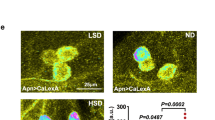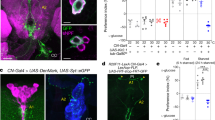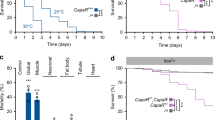Abstract
Insulin and insulin growth factor have central roles in growth1,2, metabolism3 and ageing4,5 of animals, including Drosophila melanogaster. In Drosophila, insulin-like peptides (Dilps) are produced by specialized neurons in the brain3,6. Here we show that Drosophila short neuropeptide F (sNPF), an orthologue of mammalian neuropeptide Y (NPY), and sNPF receptor sNPFR1 regulate expression of Dilps. Body size was increased by overexpression of sNPF or sNPFR1. The fat body of sNPF mutant Drosophila had downregulated Akt, nuclear localized FOXO, upregulated translational inhibitor 4E-BP and reduced cell size. Circulating levels of glucose were elevated and lifespan was also extended in sNPF mutants. We show that these effects are mediated through activation of extracellular signal-related kinases (ERK) in insulin-producing cells of larvae and adults. Insulin expression was also increased in an ERK-dependent manner in cultured Drosophila central nervous system (CNS) cells and in rat pancreatic cells treated with sNPF or NPY peptide, respectively. Drosophila sNPF and the evolutionarily conserved mammalian NPY seem to regulate ERK-mediated insulin expression and thus to systemically modulate growth, metabolism and lifespan.
This is a preview of subscription content, access via your institution
Access options
Subscribe to this journal
Receive 12 print issues and online access
$209.00 per year
only $17.42 per issue
Buy this article
- Purchase on Springer Link
- Instant access to full article PDF
Prices may be subject to local taxes which are calculated during checkout





Similar content being viewed by others
References
Colombani, J. et al. Antagonistic actions of ecdysone and insulins determine final size in Drosophila. Science 310, 667–670 (2005).
Ikeya, T., Galic, M., Belawat, P., Nairz, K. & Hafen, E. Nutrient-dependent expression of insulin-like peptides from neuroendocrine cells in the CNS contributes to growth regulation in Drosophila. Curr. Biol. 12, 1293–1300 (2002).
Rulifson, E. J., Kim, S. K. & Nusse, R. Ablation of insulin-producing neurons in flies: growth and diabetic phenotypes. Science 296, 1118–1120 (2002).
Broughton, S.J. et al. Longer lifespan, altered metabolism, and stress resistance in Drosophila from ablation of cells making insulin-like ligands. Proc. Natl Acad. Sci. USA 102, 3105–3110 (2005).
Tatar, M., Bartke, A. & Antebi, A. The endocrine regulation of aging by insulin-like signals. Science 299, 1346–1351 (2003).
Brogiolo, W. et al. An evolutionarily conserved function of the Drosophila insulin receptor and insulin-like peptides in growth control. Curr. Biol. 11, 213–221 (2001).
Bell, C. G., Walley, A. J. & Froguel, P. The genetics of human obesity. Nature Rev. Genet. 6, 221–234 (2005).
Emeson, R. B. & Morabito, M. V. Food fight: the NPY-serotonin link between aggression and feeding behavior. Sci STKE 2005, pe12 (2005).
Wahlestedt, C., Pich, E.M., Koob, G.F., Yee, F. & Heilig, M. Modulation of anxiety and neuropeptide Y-Y1 receptors by antisense oligodeoxynucleotides. Science 259, 528–531 (1993).
Lee, K. S., You, K. H., Choo, J. K., Han, Y. M. & Yu, K. Drosophila short neuropeptide F regulates food intake and body size. J. Biol. Chem. 279, 50781–50789 (2004).
Feng, G. et al. Functional characterization of a neuropeptide F-like receptor from Drosophila melanogaster. Eur. J. Neurosci. 18, 227–238 (2003).
Chung, Y. D., Zhu, J., Han, Y. & Kernan, M. J. nompA encodes a PNS-specific, ZP domain protein required to connect mechanosensory dendrites to sensory structures. Neuron 29, 415–428 (2001).
Joiner, M. A. & Griffith, L. C. Mapping of the anatomical circuit of CaM kinase-dependent courtship conditioning in Drosophila. Learn. Mem. 6, 177–192 (1999).
Colombani, J. et al. A nutrient sensor mechanism controls Drosophila growth. Cell 114, 739–749 (2003).
Hwangbo, D. S., Gershman, B., Tu, M. P., Palmer, M. & Tatar, M. Drosophila dFOXO controls lifespan and regulates insulin signalling in brain and fat body. Nature 429, 562–566 (2004).
Wang, M. C., Bohmann, D. & Jasper, H. JNK extends life span and limits growth by antagonizing cellular and organism-wide responses to insulin signaling. Cell 121, 115–125 (2005).
Cho, Y. R. & Kim, C. W. Neuropeptide Y promotes beta-cell replication via extracellular signal-regulated kinase activation. Biochem. Biophys. Res. Commun. 314, 773–780 (2004).
Kim, M. et al. MKP-3 has essential roles as a negative regulator of the Ras/mitogen-activated protein kinase pathway during Drosophila development. Mol. Cell. Biol. 24, 573–583 (2004).
Ui, K. et al. Newly established cell lines from Drosophila larval CNS express neural specific characteristics. In Vitro Cell. Dev. Biol. 30A, 209–216 (1994).
Asfari, M. et al. Establishment of 2-mercaptoethanol-dependent differentiated insulin-secreting cell lines. Endocrinol. 130, 167–178 (1992).
Hay, N. & Sonenberg, N. Upstream and downstream of mTOR. Genes Dev. 18, 1926–1945 (2004).
Puig, O., Marr, M. T., Ruhf, M. L. & Tjian, R. Control of cell number by Drosophila FOXO: downstream and feedback regulation of the insulin receptor pathway. Genes Dev. 17, 2006–2020 (2003).
Zimanyi, I. A., Fathi, Z. & Poindexter, G. S. Central control of feeding behavior by neuropeptide Y. Curr. Pharm. Des. 4, 349–366 (1998).
Wang, S., Tulina, N., Carlin, D. L. & Rulifson, E. J. The origin of islet-like cells in Drosophila identifies parallels to the vertebrate endocrine axis. Proc. Natl Acad. Sci. USA 104, 19873–19878 (2007).
Rubin, G. M. & Spradling, A. C. Genetic transformation of Drosophila with transposable element vectors. Science 218, 348–353 (1982).
Brand, A. H. & Perrimon, N. Targeted gene expression as a means of altering cell fates and generating dominant phenotypes. Development 118, 401–415 (1993).
Yu, K. et al. Processing of the Drosophila Sog protein creates a novel BMP inhibitory activity. Development 127, 2143–2154 (2000).
Acknowledgements
We thank S.K. Ju for technical support, S.H. Hong for INS-1 cell line and E. Rulifson and O. Puig for Dilp2 and dFOXO antibodies. This work was supported by grants from Korea Research Foundation (KRF-2006-312-C00637), BioGreen 21Program of Korea Rural Development Administration (20070401034024) and KRIBB Research Initiative Program (KGM 1310811).
Author information
Authors and Affiliations
Corresponding author
Supplementary information
Supplementary Information
Supplementary Figures S1, S2, S3, S4, S5 and S6 (PDF 985 kb)
Rights and permissions
About this article
Cite this article
Lee, KS., Kwon, OY., Lee, J. et al. Drosophila short neuropeptide F signalling regulates growth by ERK-mediated insulin signalling. Nat Cell Biol 10, 468–475 (2008). https://doi.org/10.1038/ncb1710
Received:
Accepted:
Published:
Issue Date:
DOI: https://doi.org/10.1038/ncb1710
This article is cited by
-
Transcriptome profiles of Anopheles gambiae harboring natural low-level Plasmodium infection reveal adaptive advantages for the mosquito
Scientific Reports (2021)
-
A novel de novo heterozygous DYRK1A mutation causes complete loss of DYRK1A function and developmental delay
Scientific Reports (2020)
-
Metabolism and growth adaptation to environmental conditions in Drosophila
Cellular and Molecular Life Sciences (2020)
-
A glucose-sensing neuron pair regulates insulin and glucagon in Drosophila
Nature (2019)
-
Sensory integration and neuromodulatory feedback facilitate Drosophila mechanonociceptive behavior
Nature Neuroscience (2017)



